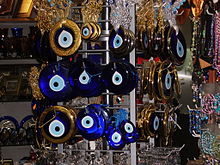Nazar (amulet): Difference between revisions
No edit summary |
No edit summary |
||
| Line 1: | Line 1: | ||
{{Merge from|Eye bead|discuss=Talk:Nazar (amulet)#Merge proposal|date=October 2013}} |
<ref>{{cite web|url=www.qomtechnique.com|website=خرمهره}}</ref>{{Merge from|Eye bead|discuss=Talk:Nazar (amulet)#Merge proposal|date=October 2013}} |
||
[[File:Nazars Greek evil eye charms.jpg|thumb||Nazars (charms against the [[evil eye]]) sold in a shop in Quincy Market of Boston, Massachusetts, USA. Note the various modifications to the simple traditional form, such as setting the nazar into butterflies or Christian imagery.]] |
[[File:Nazars Greek evil eye charms.jpg|thumb||Nazars (charms against the [[evil eye]]) sold in a shop in Quincy Market of Boston, Massachusetts, USA. Note the various modifications to the simple traditional form, such as setting the nazar into butterflies or Christian imagery.]] |
||
Revision as of 02:40, 21 May 2015

A nazar (Turkish: nazar boncuğu Old Turkic: gökçe munçuk) is an eye-shaped amulet believed to protect against the evil eye ("evil eye", from nazar and "bead" from boncuğu). The word "nazar" is derived from the Arabic نظر, "sight" or "seeing". In Turkish, it is also called Munçuk.
In Persian folklore, it is called a cheshm nazar (چشم نظر) or nazar ghorboni (نظرقربونی).[2]
In Urdu, it is also called "nazar" (نظر).
Amulet

In Central Asia, during the ages of Tengrism, people held similar superstitions like horseshoes, garlic, wolf's tooth, dried thorn, lead, stones; but the crystal blue eye has always been the most popular one.[3]
A typical nazar is made of handmade glass featuring concentric circles or teardrop shapes in dark blue, white, light blue and black, occasionally with a yellow/gold edge.[4]
It is a common sight in Turkey, Albania, Bosnia and Herzegovina, Bulgaria, Greece, Cyprus, Syria, Lebanon, Egypt, Armenia, Iran, Afghanistan, Iraq and Azerbaijan,[5] where the nazar is often hung in homes, offices, cars, children's clothing, or incorporated in jewellery and ornaments.[4] They are a popular choice of souvenir with tourists.
Eye bead
The Turkish boncuk (sometimes called a göz boncuğu 'eye bead') is a glass bead characterized by a blue glass field with a blue or black dot superimposed on a white or yellow center. Historically old, the blue bead has gained importance as an item of popular culture in Modern Turkey. The bead probably originated in the Mediterranean and is associated with the development of glass making. Written documents and extant beads date as early as the 16th century BC. Glass beads were made and widely used throughout the ancient world: from Mesopotamia to Egypt, from Phoenicia to Persia, and throughout the Roman imperial period.[6][clarification needed (Does all of this, including the reference, refer only to eye beads, also to eye beads, or just to glass beads in general? Delete if eye beads are not mentioned in the ref.)]

Other uses
The nazar image was used as a symbol on the tailfins of aeroplanes belonging to the private Turkish airline Fly Air.
It is used in the logo for CryEngine 3, a game engine designed by Crytek, a video game company founded by three Turkish brothers (Cevat, Avni and Faruk Yerli).
It was also used in the logo of the 2013 FIFA U-20 World Cup events.
Gallery
-
Nazar-inspired sculpture in the Netherlands.
-
Nazar evil eye charms.
-
A Persian cheshm nazar.
-
A Turkish nazar boncuğu.
-
Nazar on a newborn baby's hospital room's door in Turkey.
See also
References
- ^ خرمهره [www.qomtechnique.com www.qomtechnique.com].
{{cite web}}: Check|url=value (help); Missing or empty|title=(help) - ^ M.Moin: A Persian Dictionary, 3rd edition, p. 4752 (In Persian).
- ^ Langenscheidt's Pocket Turkish Dictionary.Langenscheidt, 1992, p. 638.
- ^ a b Lonely Planet Middle East.Lonely Planet; 6 edition, 2009, p. 559.
- ^ "The Evil Eye and Mountain Karma in Azerbaijan". thebriefnote.com.
- ^ Ronald T. Marchese (2005). The Fabric of Life: Cultural Transformations in Turkish Society. pp. 103–107.
{{cite book}}: Cite has empty unknown parameter:|1=(help)





